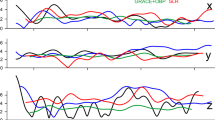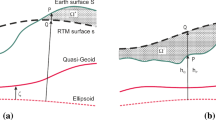Abstract
TheNWL9D (orNSWC9Z2) coordinate system is known to have thex andy coordinates of its origin approximately1 or2 meters from the Earth’s gravity center, but its zero meridian plane is supposed to form an angle (Δλ) of−0″.5 to−0″.8 with the astronomical (Greenwich) zero meridian plane. If biased geodetic longitudes are used for the calculation of an astrogeodetic geoid profile at, e.g., latitude φ=30° extending1000 km, then the geoid undulation differences between the two endpoints will differ more than2 m from the true geoid. This error will easily show up by comparison with a geoid calculated from a high-degree spherical harmonic expansion or the approximately observed geoid undulations obtained from satellite altimetry. This gives a possibility for determining Δλ as the correction (−cos φ·Δλ) which gives the best least squares agreement between the deflections of the vertical and other gravity field-dependent quantities.
An estimation of Δλ has been made using least squares collocation, because this method gives result which fulfil a least squares minimum principle. The following datasets were used.
-
(A)
301 deflections of the vertical in an area with latitude between29° and33°, and east longitude between264° and279° along the coastline of the Gulf of Mexico.
-
(B)
coefficients to maximal degree180 of two spherical harmonic expansions, and
-
(C)
sea-surface heights determined from satellite altimetry along the same coastline treated as if they were biased geoid undulations.
The deflections were used with the coefficients alone or combined with the sea-surface heights. A value of Δλ=−0″.55±0″.08 was obtained for the data combination which gave the smallest standard deviation. This result is not significantly different from the value of Δλ=−0″.50 adopted for the transformation between the North American Datum, 1983 andNWL9D (NSWC9Z2).
Similar content being viewed by others
References
C. BOUCHER: Progress Report on the Use of Space Derived Data for the RETrig Phase III. Proceedings RETrig Symposium Copenhagen 1983, (in print).
W.A. HEISKANEN and H. MORITZ: Physical Geodesy. W.H. Freeman & Co., San Francisco, 1967.
L.D. HOTHEM, D.S. ROBERTSON and W.E. STRANGE: Orientation and scale of satellite Doppler results based on combination and comparison with other space systems. Proceedings Sec. International Symposium on Problems Related to the Redefinition of North American Geodetic Networks, Arlington, Virginia, April 1978, pp. 167–180. U.S. Department of Commerce 1978.
L.D. HOTHEM, T. VINCENTY and R.D. MOOSE: Relationship between Doppler and other advanced geodetic system measurements based on global data. Proceedings Third. Int. Geodetic Symp. on Satellite Doppler Positioning, 1982, pp. 109–128, Physical Science Lab., New Mexico State Univ., Las Cruces, N.M.
F.J. LERCH, B. PUTNEY, S. KLOSKO and C. WAGNER: Goddard Earth Models for Oceanographic Applications (GEM 10B and 10C). Marine Geodesy, Vol. 5, pp. 145–187, 1981.
LIANG, Chi-Kuo: The Adjustment and Combination of GEOS-3 and Seasat Altimeter Data. Reports of the Dept. of Geodetic Science and Surveying No. 346, Ohio State Univ., Columbus, 1983.
G.A. MAUL and A. HERMAN: Mean Dynamic Topography of the Gulf of Mexico with Application to Satellite Altimetry. Marine Geodesy, Vol. 9, No. 1, pp. 27–44, 1985.
H. MORITZ: Advanced Physical Geodesy. H. Wichmann Verlag, Karlsruhe, 1980.
R.H. RAPP: The Earth’s gravity field to degree and order 180 using SEASAT altimeter data, terrestrial gravity data, and other data. Reports of the Department of Geodetic Science and Surveying No. 322, The Ohio State University, Columbus, 1981.
W. SCHLÜTER, P. PESEC, E. GRAFAREND, K. RINNER, G. SEBER and H. SEEGER: Objectives and Results of the German-Austrian Doppler Observation Campaign (DOEDOC). Presented XVII General Assembly of the IUGG, Canberra, Australia, 1979.
W.E. STRANGE and L.D. HOTHEM: Establishment of scale and orientation for satellite Doppler positions. Phil. Trans. R. Soc. Lond. A 294, pp. 335–340, 1980.
C.C. TSCHERNING: A FORTRAN IV Program for the Determination of the Anomalous Potential Using Stepwise Least Squares Collocation. Reports of the Department of Geodetic Science No. 212, The Ohio State University, Columbus, 1974.
C.C. TSCHERNING: GEOCOL—A FORTRAN—program for Gravity Field Approximation by Collocation. Technical Note, Geodaetisk Institut, 3.ed., 25 Mar. 1985a.
C.C. TSCHERNING: Geoid Modelling using Collocation in Scandinavia and Greenland. Marine Geodesy, Vol. 9, No. 1, pp. 1–16, 1985b.
H.-G. WENZEL: Hochaufloesende Kugelfunktionsmodelle fuer das Gravitationspotential der Erde. Wiss. Arb. Fachrichtung Vermessungswesen der Universitaet Hannover, (in print), 1985.
G.B. WEST: Mean Earth Ellipsoid Determined from SEASAT 1 Altimetric Observations. J. Geophys. Res., Vol. 87, No. B7, pp. 5538–5540, 1982.
H.L. WHITE and D.H. HUBER: Longitude orientation of the Doppler Reference System as Determined from Astronomic and Gravity Observations. Proceedings of the Second International Geodetic Symposium on Satellite Doppler Positioning, University of Texas, Austin, pp. 631–652, 1979.
Author information
Authors and Affiliations
Rights and permissions
About this article
Cite this article
Tscherning, C.C. Estimation of the longitude bias of the NWL9D coordinate system from deflections of the vertical, satellite altimetry and high degree spherical harmonic expansions. Bull. Géodésique 60, 29–36 (1986). https://doi.org/10.1007/BF02519352
Received:
Accepted:
Issue Date:
DOI: https://doi.org/10.1007/BF02519352




